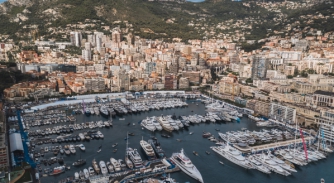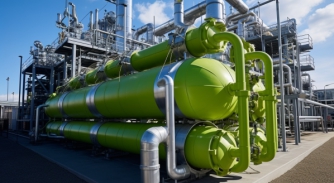The missing superyacht sustainability report
Many industries have overarching sustainability reports, providing insights and accountability. Where is the superyacht equivalent performance assessment?
We are witnessing an increase in sustainability reports from individual companies within the superyacht industry, including MB92 and Amico&Co. However, when we look at other organisations and associated industry bodies, such as the Cruise Lines International Association (CLIA) and the European Union Aviation Safety Agency (EASA), they have released reports detailing their sector's overall performance and efforts in sustainability and environmental impacts.
Due to some notable overlap, the existence of these documents and their contents can shed light on what the superyacht industry could do in the same fields. One example is a recent publication from the Cruise Lines International Association (CLIA), titled "Charting the Future of Sustainable Cruise Travel." This document details some of the various efforts being made across the cruise industry to improve its impact across the three main pillars of sustainability: Environment, people, and governance.
In terms of environmental performance, one similarity to the superyacht and wider maritime industries is the varied approaches being made to achieve reduced emissions to align with both Emission Control Areas and the recently revised IMO Greenhouse Gas Protocol. A significant focus has been on the electrification and improved efficiency of the fleet and port facilities to allow for the use of shore power, reducing emissions while in port. Alongside this, there is also a similar development of both infrastructure and capability to ensure increased use of alternative fuels with reduced environmental impact potential, such as LNG and Methanol.
Looking towards the current fleet, there is also a discussion of the use of exhaust gas cleaning systems (EGCS), which are "designed to remove 98% of sulfur and well over 50% of particulate matter, with a 12% reduction in NOx." Implementing emission reductions like these is key to reducing the impact of the entire fleet, alongside the important focus on future projects as highlighted in this document to radically reduce emissions.
Alongside the environmental topics discussed in the document, something the report delves into that is more rarely seen in the superyacht industry is that of the people it impacts, both the seafarers who work on board and the communities surrounding the destination ports. These sections detail how the industry is encouraging the next generation, making it a more accessible and diverse industry to work for, as well as an industry that is conscious of training/development and the health and well-being of seafarers onboard. The wide positive impact the industry has on the economy is also quantified, through both job generation onboard and ashore, as well as the money injected into the destination port areas.
Another industry that has faced similar scrutiny to the superyacht industry is that of aviation. EASA has released an environmental report tracking the performance and efforts affecting the environmental impact. While it isn't as broad as the CLIA document, it is still an interesting document for a wider context of how other industries are tackling the same issues. Minimal reductions in impacts were shown in the industry post-COVID, although forecasts remain optimistic for longer-term improvements despite predicting emission growth in the short term.
One element this report includes that the others don't is the identification of risks to the industry caused by the effects of global warming, such as increased temperatures in Europe affecting aircraft performance, causing heat damage and leading to changes in tourism demand, or weather changes, such as increased rainfall and more intense storms causing delays, cancellations, rerouting, and damage to terminals, access routes, and navigational equipment.
While all of the above content is specific to these industries, there could easily be similar discussions of topics for the superyacht industry. Tracking the efforts to improve the environmental and social impact across the industry, measuring the positive benefits to the economy that many tout when confronted by environmental issues, as well as identifying environmental risks to the industry and detailing programs looking after current and potential future seafarers onboard superyachts.
Presenting collated information like this could provide accountability and transparency to our industry at a time when improving our image to the global public is critical. However, as creating this type of document would require a lot of work, there seems to be a chicken-and-egg scenario within our industry preventing its creation. As we haven't united ourselves in our sustainability effort, we are unable to commit to wider efforts such as the IMO GHG protocol that would encourage an overarching report.
The irony is, that perhaps because we haven't aligned with any sustainability requirements such as the protocol, we aren't driven to unite our efforts enough to be capable of creating documents similar to those referenced in this article.
NEW: Sign up for SuperyachtNewsweek!
Get the latest weekly news, in-depth reports, intelligence, and strategic insights, delivered directly from The Superyacht Group's editors and market analysts.
Stay at the forefront of the superyacht industry with SuperyachtNewsweek
Click here to become part of The Superyacht Group community, and join us in our mission to make this industry accessible to all, and prosperous for the long-term. We are offering access to the superyacht industry’s most comprehensive and longstanding archive of business-critical information, as well as a comprehensive, real-time superyacht fleet database, for just £10 per month, because we are One Industry with One Mission. Sign up here.
Related news

Mixed messaging or meaningful change?
Megan Hickling, TSG’s new Sustainability Editor, argues that the superyacht industry should be taking major initiatives that can actually be measured
Opinion

DNV’s energy predictions for the future
The recently released Energy Transition Outlook (ETO) by the Classification Society sheds light on the future energy transition away from fossil fuels
Technology

Cambridge University to build zero-emission catamaran
The University of Cambridge and Propulsion House Pulling-e have joined forces ahead of the Monaco Energy Boat Challenge next year
Crew

Methanol's colour coding conundrum
Methanol is fast becoming a popular, environmentally friendly alternative fuel, but it is important to understand that not all methanol is created equal
Technology

Feadship – On the Road to Zero
CEO Henk de Vries assesses Feadship’s plan to build carbon-neutral superyachts by 2030, and the wider sector’s green ambitions
Business
Related news
Mixed messaging or meaningful change?
1 year ago
DNV’s energy predictions for the future
1 year ago
Methanol's colour coding conundrum
1 year ago
Feadship – On the Road to Zero
1 year ago
NEW: Sign up for
SuperyachtNewsweek!
Get the latest weekly news, in-depth reports, intelligence, and strategic insights, delivered directly from The Superyacht Group's editors and market analysts.
Stay at the forefront of the superyacht industry with SuperyachtNewsweek



